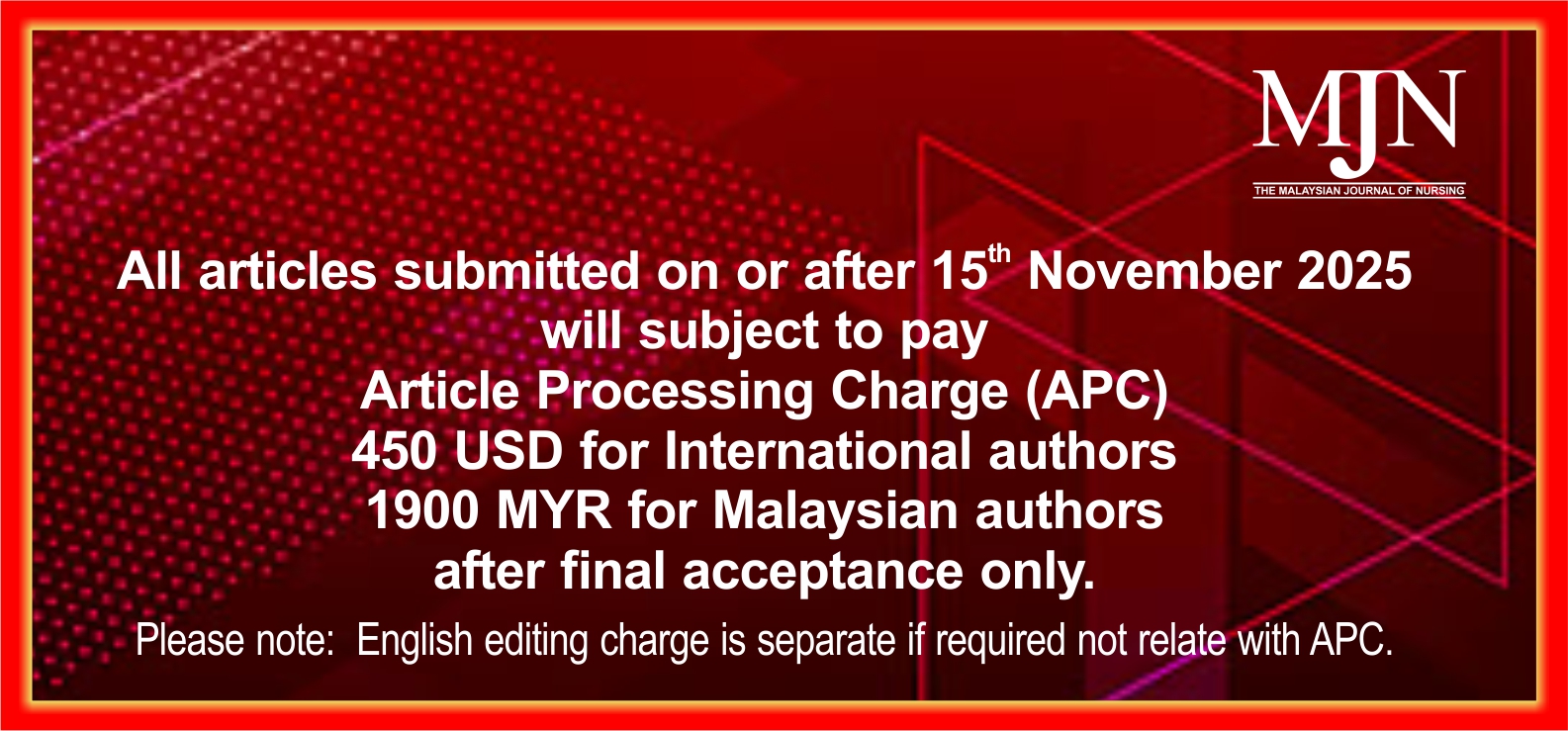Cognition and Perception of Critical Care Nurses Regarding Non-Invasive Positive Pressure Ventilation
DOI:
https://doi.org/10.31674/mjn.2024.v16i02.004Abstract
Background: The use of non-invasive positive pressure ventilation (NIPPV) has increased substantially in the last three decades as it moved from critical care to ward settings and became an essential tool to manage respiratory failure. To provide a good standard of care, it is crucial that nurses providing NIPPV care to patients have knowledge and a positive attitude within their area of competence. Objective: To determine the level of knowledge and attitude of nurses who provide NIPPV patient care and to associate the findings with the selected demographic variables. Methods: A descriptive cross-sectional study was carried out from May to June 2023 with 280 nurses working at various critical care units in a tertiary-level hospital, selected through convenience sampling technique. Data was collected using a questionnaire prepared by the researchers and analyzed using SPSS version 27. Descriptive and inferential statistics were employed for the analysis. Normality of the data was ensured by using the Q-Q plot and the Shapiro-Wilk test. The Fisher exact test was used to compute association with demographic variables. The level of statistical significance was set at ≤ 0.05 for all analyses. Results: The majority (68.9%) of nurses had inadequate knowledge of NIPPV with an overall knowledge mean score of 13 ± 3.45, and the majority (69.3%) maintained a neutral attitude, with 27.1% expressing negativity and a small proportion (3.6%) of nurses demonstrating a positive attitude. Notably, none of the participants had attended critical care training. There was a significant association found between knowledge levels and attitude with age (p value 0.035) and the total years of experience (p value <0.001) in nursing. There was a negative correlation found between knowledge and attitude, computing a Karl Pearson correlation coefficient of -0.248 (p<0.001). Conclusion: The study findings emphasize the necessity for targeted in-service education and interventions to ensure a comprehensive and positive approach to enhance the quality of care provided by the nurses in the context of patients receiving non-invasive positive pressure ventilation therapy.
Keywords:
Attitude, Knowledge, Non-Invasive Positive Pressure Ventilation, NursesDownloads
References
Adams, N. E. (2015). Bloom’s taxonomy of cognitive learning objectives. Journal of the Medical Library Association( JMLA), 103(3), 152. https://doi.org/10.3163/1536-5050.103.3.010
Ahmalia, R., Aljaberi, M. A., & Said, M. S. M. (2024). Adoption of Information and Technology Communication in Ulcer Pressure Prevention: A Narrative Review. International Journal of Advancement in Life Sciences Research, 7(1), 15-23. https://doi.org/10.31632/ijalsr.2024.v07i01.002
Akoumianaki, E., Ischaki, E., Karagiannis, K., Sigala, I., & Zakyn-Thinos, S. (2021). The Role of Noninvasive Respiratory Management in Patients with Severe COVID- 19 Pneumonia. Journal of Personalized Medicine, 11(9), 884. https://doi.org/10.3390/jpm11090884
Anderson, L. W., & Krathwohl, D. R. (2001). A Taxonomy for Learning, Teaching, And Assessing: A Revision of Bloom's Taxonomy of Educational Objectives: Complete Edition. Addison Wesley Longman, Inc, US. 352 pages https://eduq.info/xmlui/handle/11515/18824. Accessed on 21th January, 2024.
Annarani, A., Chacko, S., Lucas, A., Rebekah, G., Umesh, S., Ann, S., & Ravi, V. (2017). Knowledge of nurses regarding Non Invasive Ventilation (NIV) therapy. International Journal of Science and Research, 6(5), 925-928. https://www.ijsr.net/archive/v6i5/ART20173390.pdf. Accessed on 20th January, 2024.
Aziz, A. R., & Abdul-Hamza, M. A. (2017). Effectiveness of an Educational Program upon nurses’ knowledge toward The Continuous Positive Airway Pressure (CPAP) Machine in Neonatal Intensive Care Unit at Al-Diwanyia City Hospitals. International Journal of Scientific and Research Publications, 7(8), 460-468. https://www.ijsrp.org/research-paper-0817/ijsrp-p6856.pdf. Accessed on 21st January, 2024.
Bambi, S., Parente, E., Bardacci, Y., Baldassini Rodriguez, S., Forciniti, C., Ballerini, L., ... & Lucchini, A. (2022). The effectiveness of NIV and CPAP training on the Job in COVID-19 acute care wards: A Nurses’ self-assessment of skills. Nursing Reports, 13(1), 17-28. https://doi.org/10.3390%2Fnursrep13010002
Carron, M., Freo, U., BaHammam, A. S., Dellweg, D., Guarracino, F., Cosentini, R., ... & Esquinas, A. (2013). Complications of non-invasive ventilation techniques: a comprehensive qualitative review of randomized trials. British Journal of Anaesthesia, 110(6), 896-914. https://doi.org/10.1093/bja/aet070
Chaudhary, A, S. Perera A. S., Natha, H. (2022). A study to assess effectiveness of skill competency programme regarding on HFNC & non-invasive ventilation in terms of knowledge & practice among staff nurses in selected hospital, at Meerut, Uttar Pradesh. Journal of Nursing and Health Science, 11(6), 21-24. https://doi.org/10.9790/1959-1106042124
Correa, T. D., Sanches, P. R., de Morais, L. C., Scarin, F. C., Silva, E., & Barbas, C. S. V. (2015). Performance of non-invasive ventilation in acute respiratory failure in critically ill patients: A prospective, observational, cohort study. BMC Pulmonary Medicine, 15(144), 1-8. https://doi.org/10.1186/s12890-015-0139-3
Davies, M., Allen, M., Bentley, A., Bourke, S. C., Creagh-Brown, B., D’Oliveiro, R., ... & Setchfield, I. (2018). British Thoracic Society Quality Standards for acute non-invasive ventilation in adults. BMJ Open Respiratory Research, 5(1), e000283. https://doi.org/10.1136/bmjresp-2018-000283
Davidson, C., Banham, S., Elliott, M., Kennedy, D., Gelder, C., Glossop, A., ... & Thomas, L. (2016). British Thoracic Society/Intensive Care Society Guideline for the ventilatory management of acute hypercapnic respiratory failure in adults. BMJ Open Respiratory Research, 3(1), e000133. https://doi.org/10.1136/bmjresp-2016-000133
Elsobkey, F. A., & Amer, S. A. M. (2018). Effect of educational guidelines program about nursing care of neonates receiving continues positive airway pressure. IOSR Journal of Nursing and Health Sciences, 7(3),16-26. https://doi.org/10.9790/1959-0703091626
Gírio, R., & Sousa, J. S. (2024). An educational intervention impact in improving nurses' knowledge of noninvasive ventilation. Revista de Investigação & Inovação em Saúde, 7(2), 1-11. https://doi.org/10.37914/riis.v7i2.370
Goel, N. N., Owyang, C., Ranginwala, S., Loo, G. T., Richardson, L. D., & Mathews, K. S. (2020). Noninvasive ventilation for critically ill subjects with acute respiratory failure in the emergency department. Respiratory Care, 65(1), 82-90. https://doi.org/10.4187/respcare.07111
Goktaş, S., Kıraner, E., Dogan, P., & Tunalı, B. (2017). Effects of provided trainings regarding non-invasive mechanical ventilation on the knowledge level of nurses. Eurasian Journal of Pulmonology, 19(1), 19-24. https://doi.org/10.5152/ejp.2016.05706
Hammod, H. J., & Mohammed, S. (2016). Effectiveness of an Educational Program on Nurses Knowledge Concerning Complications Prevention of Mechanical Ventilation at Intensive Care Unit in Al-Hussain Teaching Hospital at Nassiryah City. Kufa Journal for Nursing Sciences, 6(2) 1-11 https://doi.org/10.36321/kjns.vi20162.2658.
Hoo, G. W. S. (2018). Noninvasive Ventilation. Medscape. http://emedicine.medscape.com/article/304235. Accessed on 16th February, 2024.
Hyzy, R. C., & McSparron, J. I. (2023). Noninvasive ventilation in adults with acute respiratory failure: Benefits and contraindications. UpToDate. https://www.uptodate.com/contents/noninvasive-ventilation-in-adults-with-acute-respiratory-failure-benefits-and-contraindications. Accessed on 19th January, 2024.
Kim, J. Y., Lee, Y. J., & Korean Association of Wound Ostomy Continence Nurses. (2019). Medical Device‐Related Pressure Ulcer (MDRPU) in acute care hospitals and its perceived importance and prevention performance by clinical nurses. International Wound Journal, 16(Suppl 1), 51-61. https://doi.org/10.1111/iwj.13023
Kothari, C. R. (2004). Research methodology: Methods and techniques. New Age International. https://efaidnbmnnnibpcajpcglclefindmkaj/https://eprints.itn.ac.id/13616/1/Research-Methodology-CR-Kothari.pdf . Accessed on 14th October, 2023.
Lomnyack, W. P., Mwansisya, T., Mbelwa, S., Isangula, K., & Abraham, Z. S. (2021). Knowledge about continuous positive airway pressure machine usage among nurses at a tertiary hospital in Tanzania. South Sudan Medical Journal, 13(4), 131-135. https://www.ajol.info/index.php/ssmj/article/view/205346. Accessed on 20th March, 2024.
Nyalla, A. M. O. M. (2018). Wastage of imaging materials in medical conventional, specialised imaging and the relationship in continuous professsional development. Malaysian Journal of Medical Research (MJMR), 2(2), 8-12. http://dx.doi.org/10.31674/mjmr.2018.v02i02.002
Polit, D. F., & Beck, C. T. (2008). Nursing research: Generating and assessing evidence for nursing practice. Lippincott Williams & Wilkins. https://books.google.co.in/books/about/Nursing_Research.html?id=Ej3wstotgkQC&redir_esc=y. Accessed on 16th August, 2023.
Raurell-Torredà, M., Argilaga-Molero, E., Colomer-Plana, M., Ruiz-García, T., Galvany-Ferrer, A., & González-Pujol, A. (2015). Intensive care unit profesionals's knowledge about non invasive ventilation comparative analysis. Enfermeria Intensiva, 26(2), 46-53. http://doi.org/101016/j.enfi.2018:04.006
Raurell-Torredà, M., Argilaga-Molero, E., Colomer-Plana, M., Ródenas-Francisco, A., & Garcia-Olm, M. (2019). Nurses’ and physicians’ knowledge and skills in non-invasive ventilation: equipment and contextual influences. Enfermería Intensiva (English ed.), 30(1), 21-32. https://doi.org/10.1016/j.enfie.2018.04.004
Salmond, S. W., & Echevarria, M. (2017). Healthcare transformation and changing roles for nursing. Orthopaedic Nursing, 36(1), 12-25. https://doi.org/10.1097/nor.0000000000000308
Saltürk, C., Kargın, F., Berk Takır, H., Adıgüzel, N., GüNGÖR, G., & Balcı, M. (2012). Yoğun bakım ünitesinde gece noninvaziv mekanik ventilasyon maske uygulama sıklığı. [Frequency of nightly noninvasive mechanical ventilation mask application in the intensive care unit]. Göztepe Tıp Dergisi, 27(3), 90-93. https://doi.org/10.5222/J.GOZTEPETRH.2012.090
Sanchez, D., Smith, G., Piper, A., & Rolls, K. D. (2014). Non-invasive Ventilation Guidelines for Adult Patients with Acute Respiratory Failure. Agency for Clinical Innovation (N.S.W.). https://www.aci.health.nsw.gov.au/__data/assets/pdf_file/0007/239740/ACI14_Man_NIV_1-2.pdf . Accessed on 15th June, 2023.
Scala, R., & Pisani, L. (2018). Noninvasive ventilation in acute respiratory failure: which recipe for success?. European Respiratory Review, 27(149). https://doi.org/10.1183/16000617 0029-20
Schmidt, M., Boutmy-Deslandes, E., Perbet, S., Mongardon, N., Dres, M., Razazi, K., & Demoule, A. (2016). Differential perceptions of noninvasive ventilation in intensive care among medical caregivers, patients, and their relatives: a multicenter prospective study—The PARVENIR Study. Anesthesiology, 124(6), 1347-1359. https://doi.org/10.1097/ALN.0000000000001124
Siam, B. H. A., Alenazi, A. M. S., & Mahmoud, S. K. M. (2023). Nurses' knowledge regarding noninvasive positive pressure in acute respiratory failure. Egyptian Journal of Health Care, 14(2), 458-465. https://doi.org/10.21608/ejhc.2023.297446
Spiteri, P. (2022). Acute and Critical Care Nurses’ Knowledge of Non-Invasive Ventilation (master’s dissertation). University of Malta. https://www.um.edu.mt/library/oar/handle/123456789/110110. Accessed on 20th February, 2024.
Tarhan, M., Hançer, O., Polat, F., Gokduman, S. A., & Dalar, L. (2015). Non-invasive mechanical ventilation knowledge level of the nurses: A questionnaire survey in a tertiary care training and research hospital. Eurasian Journal of Pulmonology, 17, 163-170. https://dx.doi.org/10.5152/ejp.2015.14633
Tobin, M. J. (2020). Basing respiratory management of COVID-19 on physiological principles. American Journal of Respiratory and Critical Care Medicine, 201(11), 1319-1320. https://doi.org/10.1164/rccm.202004-1076ED
Tobin, M. J., Jubran, A., & Laghi, F. (2021). Noninvasive strategies in COVID-19: Epistemology, randomised trials, guidelines, physiology. European Respiratory Journal, 57(2), 2004247. https://doi.org/10.1183/13993003.04247-2020
Tobin, M. J., Laghi, F., & Jubran, A. (2020). Caution about early intubation and mechanical ventilation in COVID-19. Annals of Intensive Care, 10, 1-3. https://doi.org/10.1186/s13613-020-00692-6
Withers, A., Man, T. C. C., D'Cruz, R., de Vries, H., Fisser, C., Ribeiro, C., ... & Patout, M. (2021). Highlights from the respiratory failure and mechanical ventilation 2020 conference. ERJ Open Research, 7(1). https://doi.org/10.1183%2F23120541.00752-2020
Published
How to Cite
Issue
Section
License
Copyright (c) 2024 The Malaysian Journal of Nursing (MJN)

This work is licensed under a Creative Commons Attribution-NonCommercial-NoDerivatives 4.0 International License.



































